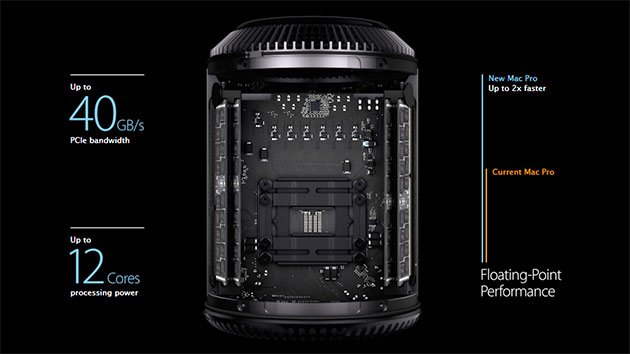Apple Also Announces New Retina MacBook Pros, Free OS X Mavericks Upgrade, Lightweight iPad Air
As expected, Apple announced new details of the Mac Pro launch today, pegging the sleek desktop workstation for a December launch at a starting price of $2999.
Three grand buys you a pretty capable machine, starting with a 3.7 GHz quad-core Intel Xeon E5 CPU (running at up to 3.9 GHz in turbo-boost mode) with 10 MB of L3 cache, 12 GB of 1866 MHz DDR3 ECC RAM, dual AMD FirePro D300 graphics processors with 2 GB of GDDR5 VRAM each (amounting to 160 GB/sec of memory bandwidth), and 256 GB of PCIe-based flash storage. That system can be reconfigured with up to a 2.7 GHz 12-core CPU, 64 GB of RAM, dual FirePro D500 or D700 graphics. and as much as 1 TB of flash storage.
Not fast enough? Grab another bill. For $3999, you start with a 3.5 GHz six-core Intel Xeon E5 CPU with 12 MB of L3 cache (again, up to 3.9 GHz when turbo-boosted), 16 GB of 1866 MHz DDR3 ECC RAM, and dual AMD FirePro D500 graphics processors with 3 GB of GDDR5 VRAM each (240 GB/sec of memory bandwidth), and the same 256 GB of storage. Upgrades will take that system to the same top specs as the base Mac Pro, but the exact prices of the different system configurations haven't been announced.
At a special event held today in San Francisco, Apple reiterated that the Mac Pro will be accompanied by a "new generation" version of Final Cut Pro and said filmmaker Dean Devlin has been a beta user of the software Devlin offered this endorsement: "The Mac Pro makes real-time 4K video editing a reality. It's more powerful than I ever imagined, and it will change the way I make movies."
Apple was also promoting the machine as a great workstation for a recording studio, claiming that it puts out only 12 dB of sound when idling, and was designed to be no louder than a Mac mini. And Apple reminded everyone that the Mac Pro is being assembled in the U.S., with over 2,000 people in 20 states contributing to the effort.
For more on the Mac Pro, check Apple's tech specs for the $2999 and $3999 versions.
Apple also broke from tradition with the announcement of Mavericks, the new Mac OS X version, which is available today for free. (An upgrade to Mountain Lion, Apple's previous OS version, was $29.)
The MacBook Pros with Retina Displays got updated to Intel's Haswell chips and Iris graphics, with the 13-inch version starting at $1299 (2.4 GHz Core i5 CPU, 4 GB of RAM, and 128 GB SSD) and the 15-inch model starting at $1999 (2.4GHz quad-core i7 CPU, 8 GB of RAM). Boosting that system to 8 GB of RAM and 256 GB of flash storage raises the price to $1499, and a system with a 2.6 GHZ processor and 512 GB of storage increase the price to $1799.
The 15-inch version starts at $1999 for a 2.0 GHz quad-core Intel Core i7 (with turbo boost up to 3.2 GHz), 8 GB of RAM and 256 GB of storage, with a jump to $2599 buying a 2.3GHz quad-core i7, 16 GB of RAM, 512 GB of storage, and Nvidia GeForce GT 750M graphics hardware backing up Intel's Iris Pro graphics. Apple's only non-Retina MacBook is now the 13-inch 2.5 GHz dual-core i5 entry-level model, with 500 GB HDD, that sells for $1,199.
All of the new Macs are shipping now with OS X Mavericks and new versions of iWork and iLife installed.
And finally, Apple debuted the lightweight $499 iPad Air — 7.5 mm thick, with a thinner bezel than its predecessor, and weighing just one pound — and a new $399 iPad mini with a retina display, lowering the existing iPad mini to $299 and leaving the full-sized, non-Retina iPad 2 at its existing $399. The iPad Air ships November 1.
Sections: Technology
Topics: New product apple ipad air Mac Pro MacBook Pro
Did you enjoy this article? Sign up to receive the StudioDaily Fix eletter containing the latest stories, including news, videos, interviews, reviews and more.
